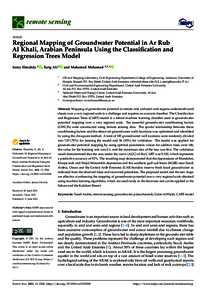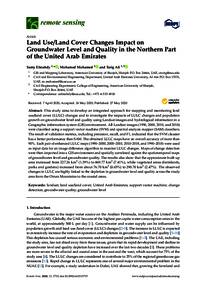Document
Regional mapping of groundwater potential in Ar Rub Al Khali, Arabian Peninsula using the classification and regression trees model.
Identifier
DOI: 10.3390/rs13122300
Source
Remote Sensing. v. 13, 12, 2300
Contributors
Ali, Tarig., Author
Mohamed, Mohamed., Author
Country
Switzerland
Publisher
MDPI AG.
Gregorian
2021-06-02
Language
English
Subject
English abstract
Mapping of groundwater potential in remote arid and semi-arid regions underneath sand sheets over a very regional scale is a challenge and requires an accurate classifier. The Classification and Regression Trees (CART) model is a robust machine learning classifier used in groundwater potential mapping over a very regional scale. Ten essential groundwater conditioning factors (GWCFs) were constructed using remote sensing data. The spatial relationship between these conditioning factors and the observed groundwater wells locations was optimized and identified by using the chi-square method. A total of 185 groundwater well locations were randomly divided into 129 (70%) for training the model and 56 (30%) for validation. The model was applied for groundwater potential mapping by using optimal parameters values for additive trees were 186, the value for the learning rate was 0.1, and the maximum size of the tree was five. The validation result demonstrated that the area under the curve (AUC) of the CART was 0.920, which represents a predictive accuracy of 92%. The resulting map demonstrated that the depressions of Mondafan, Khujaymah and Wajid Mutaridah depression and the southern gulf salt basin (SGSB) near Saudi Arabia, Oman and the United Arab Emirates (UAE) borders reserve fresh fossil groundwater as indicated from the observed lakes and recovered paleolakes. The proposed model and the new maps are effective at enhancing the mapping of groundwater potential over a very regional scale obtained using machine learning algorithms, which are used rarely in the literature and can be applied to the Sahara and the Kalahari Desert.
ISSN
2072-4292
Resource URL
Category
Journal articles


